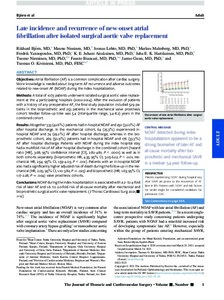Late incidence and recurrence of new-onset atrial fibrillation after isolated surgical aortic valve replacement
Nieminen Tuomo; Gunn Jarmo; Malmberg Markus; Björn Rikhard; Nissinen Maunu; Airaksinen KE Juhani; Kiviniemi Tuomas O; Biancari Fausto; Hartikainen Juha EK; Lehto Joonas; Yannopoulos Fredrik
https://urn.fi/URN:NBN:fi-fe2021093047903
Tiivistelmä
Atrial fibrillation (AF) is a common complication after cardiac surgery. More knowledge is needed about long-term AF recurrence and adverse outcomes related to new-onset AF (NOAF) during the index hospitalization.
A total of 1073 patients underwent isolated surgical aortic valve replacement at the 4 participating hospitals (2002-2014). After the exclusion of patients with a history of any preoperative AF, the final study population included 529 patients in the bioprosthetic and 253 patients in the mechanical valve prosthesis cohort. Median follow-up time was 5.4 (interquartile range, 3.4-8.2) years in the combined cohort.
Altogether 333 (42.6%) patients had in-hospital NOAF and 250 (32.0%) AF after hospital discharge. In the mechanical cohort, 64 (25.3%) experienced in-hospital NOAF and 74 (29.2%) AF after hospital discharge, whereas in the bioprosthetic cohort, 269 (50.9%) patients had in-hospital NOAF and 176 (33.3%) AF after hospital discharge. Patients with NOAF during the index hospital stay had a multifold risk of AF after hospital discharge in the combined cohort (hazard ratio [HR], 3.68; 95% confidence interval [CI], 2.82-4.81; P < .0001) as well as in both cohorts separately (bioprosthetic: HR, 4.35; 95% CI, 3.05-6.22; P < .001; mechanical: HR, 2.54; 95% CI, 1.59-4.03; P < .001). Patients with an in-hospital NOAF also had a significantly higher adjusted risk of death during the follow-up in the mechanical (HR, 2.05; 95% CI, 1.10-3.82; P = .025) and bioprosthetic (HR, 1.63; 95% CI, 1.17-2.28; P = .004) valve prosthesis cohorts.
NOAF during the index hospitalization is associated with a 2- to 4-fold risk of later AF and 1.6- to 2.0-fold risk of all-cause mortality after mechanical and bioprosthetic surgical aortic valve replacement.
Kokoelmat
- Rinnakkaistallenteet [19207]
